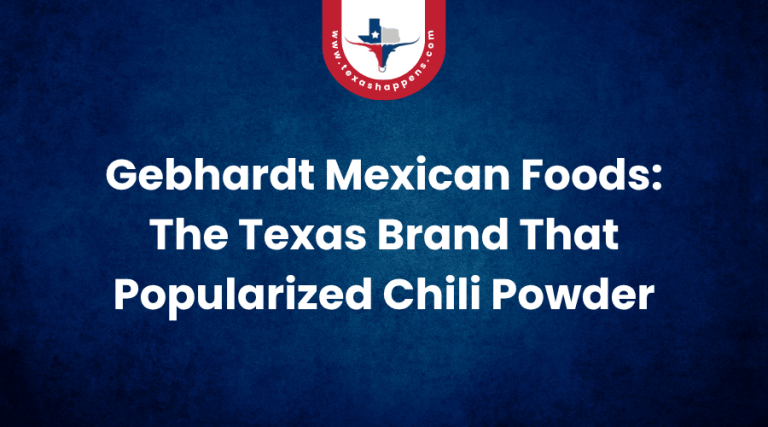William Gebhardt, a German immigrant who settled in Texas in the 1890s, revolutionized American cooking by creating the first commercial chili powder. His Eagle Brand trademark (1896) launched a Tex-Mex food empire that grew from a small New Braunfels café to a national operation selling canned chili, tamales, and spices.
You’ll discover how this visionary entrepreneur transformed Mexican flavors into everyday American kitchen staples.
William Gebhardt: From German Immigrant to Tex-Mex Pioneer
While many American food innovations emerged from kitchens of immigrants adapting to their new home, few have had the lasting impact of William Gebhardt’s culinary ingenuity. This German immigrant settled in New Braunfels, Texas in the 1890s, where he opened a café and began grinding and drying peppers to create consistent chili powder.
Gebhardt’s creativity led him to register the “Eagle Brand” trademark in 1896. With financial backing from his brother-in-law, he relocated to San Antonio in 1898, expanding his operation.
His 1908 cookbook became one of the first focused on Mexican-American cuisine, cementing his role in popularizing Tex-Mex foods nationwide. Gebhardt fundamentally established the commercial groundwork for what Americans now recognize as Tex-Mex cuisine.
His culinary path began in New Braunfels, a town with strong German heritage that influenced many aspects of Texas Hill Country culture.
The Birth of Eagle Brand Chili Powder and Early Business Success
View this post on Instagram
Before chili powder became a pantry staple, William Gebhardt’s entrepreneurial foresight transformed regional Mexican flavors into a commercial success. After opening his New Braunfels café, Gebhardt registered his Eagle Brand trademark in 1896, creating America’s first mass-produced chili powder.
With his brother-in-law’s support, Gebhardt moved operations to San Antonio in 1898, where his Mexican Foods Company grew quickly. By 1915, it was among the leading spice manufacturers, producing thousands of bottles daily and earning impressive profits.
Gebhardt’s brilliance went beyond branding and distribution. His 1908 cookbook—among the earliest devoted to Mexican-American food—educated Americans on how to use chili powder, reshaping American seasoning habits.
Just as Dr Pepper’s secret formula helped it gain fame at the 1904 World’s Fair, Gebhardt’s chili powder became a defining flavor in American kitchens.
Expanding Beyond Spices: Gebhardt’s Growing Product Empire
Gebhardt’s business savvy reached far beyond spices in the early 1900s. After obtaining a butcher’s license in 1911, the company expanded into canned chili and tamales, evolving into a full-service Mexican food brand.
By 1915, Gebhardt Chili Powder helped elevate the company to one of the largest producers in its category. With multiple plants and a growing workforce, they produced up to 18,000 bottles daily and generated nearly $1 million in annual revenue.
The company vertically integrated by cultivating ancho chiles on leased plots in Mexico, ensuring quality and supply. This forward-thinking mirrored the industrial innovation shaping early 20th-century America.
Gebhardt’s expanding product line—eventually including canned beans, salsas, and dips—extended their reach nationally and abroad.
This innovative business approach mirrored the industrial ingenuity that characterized early 20th century American manufacturing.
Marketing Innovations and Global Reach of a Texas Brand
View this post on Instagram
Millions of Americans discovered Mexican flavors thanks to Gebhardt’s groundbreaking marketing strategies, which helped ethnic foods gain acceptance in everyday American life. The company used radio jingles, illustrated packaging, and other visual branding to connect with mainstream shoppers.
To guarantee consistency, Gebhardt cultivated ancho peppers on dedicated farms in Mexico. Their devotion to quality led to ambitious ventures like opening a Mexican restaurant in New York City, exposing urban diners to Texan-style dishes.
These bold moves, paired with catchy slogans and dependable product availability, helped normalize Mexican-inspired convenience foods in U.S. kitchens.
At its peak, Gebhardt’s product line reached 19 countries, with chili powder leading its global exports.
Ownership Changes and Corporate Evolution Through the Decades
After operating as a family-run business for nearly 60 years, Gebhardt Mexican Foods entered a new chapter when it was acquired by Beatrice Foods in 1960. Though now part of a large conglomerate, the brand maintained a strong identity through several ownership shifts:
- Kohlberg Kravis Roberts & Co. acquired Beatrice in 1985, integrating Gebhardt into Hunt-Wesson
- ConAgra purchased Hunt-Wesson in 1990, absorbing the Gebhardt brand
- The San Antonio production plant later closed during corporate restructuring
Despite these transitions, Gebhardt products remain on store shelves. Over a century of evolution has not diminished their Tex-Mex identity, a testament to the brand’s cultural significance and consumer loyalty.
Cultural Impact and Enduring Legacy in American Cuisine
The American food landscape shifted permanently when Gebhardt Mexican Foods introduced chili powder to households nationwide. You’ve likely tasted this flavor legacy every time you enjoy a Tex-Mex dish. Through bold branding and educational outreach, Gebhardt helped integrate Mexican-American cooking into the national palate.
Their packaging and slogans positioned chili powder as an essential kitchen item, redefining how Americans approached seasoning. From tacos to chili con carne, today’s Tex-Mex staples owe their familiar spice profile to Gebhardt’s innovation. The brand’s influence continues in contemporary cooking, securing its place in American culinary history.


